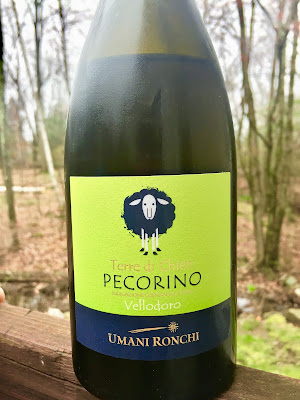I
love when we have months where our Italian Food, Wine & Travel
group focuses on the autochthonous, or indigenous, grapes that are
lesser known to the average consumer. Even though it can be a challenge
to seek one out it gives you a perspective on everything a region has
to offer than those that are just commonplace in the market. Especially
with this month’s feature of the pecorino grape as this was one an
almost extinct varietal, but has so much to share with our white wine
lovers.
Pecorino
is a grape that hails from the Abruzzo and neighboring Le Marche wine
regions. The producer I tried, Umani Ronchi, produces wines in both of
these countries. Pecorino is not the shining star when it comes to
white wines in these regions as verdicchio in my opinion runs the show, but definitely holds a place in the running. As
I write this it’s eating my soul that I had an opportunity to take a
press trip and tour this region this month and really discover more of
this grape and understand Abruzzo’s terroir, but my 2 little ones need
me and unfortunately had to postpone until a later time.
The Winery ~ Umani Ronchi
Umani Ronchi is owned and operated today by the Bianchi-Bernetti family and is run by Michele Bernetti overseen by his father, Massimo. It originally started by in the 50’s when Gino Umani Ronchi started a farm in the Cupramontana of the Le Marche. The Bianchi-Bernetti family then took the estate over a few years later. Massimo was the visionary and driving force behind developing Umani Ronchi in a number of ways when he was later joined by his son in the 90’s. The recognitions they have received over the years and their partnership with Giacomo Tachis focusing on international varieties with their Pelago wine help put them on the map across the wine world.
Umani Ronchi is owned and operated today by the Bianchi-Bernetti family and is run by Michele Bernetti overseen by his father, Massimo. It originally started by in the 50’s when Gino Umani Ronchi started a farm in the Cupramontana of the Le Marche. The Bianchi-Bernetti family then took the estate over a few years later. Massimo was the visionary and driving force behind developing Umani Ronchi in a number of ways when he was later joined by his son in the 90’s. The recognitions they have received over the years and their partnership with Giacomo Tachis focusing on international varieties with their Pelago wine help put them on the map across the wine world.
With
over 500 acres of vineyards, the winery has doubled its land under
vines from the 70’s and has replanted over 85% of their vines. They
have 10 vineyard sites spread amongst Abruzzo (near Teramo) and Conero
and Castelli di Jesi
in Le Marche with 3 winemaking facilities. Speaking of recent talks of
organics and biodynamics, Umani Ronchi also practices organic farming
practices throughout all of their vineyards as well as practices taken
to be sustainable.
 |
| Copyright of Umani Ronchi |
2017 Umani Ronchi Terre di Chieti Velladoro Pecorino IGT
The sheep on the label represents the pecorino grape since the word stems from the word pecora, meaning sheep. This wine is grown in Monti Pagano of Abruzzo that overlooks the Gran Sasso mountains. It is 100% hand picked pecorino. Umani Ronchi began a project working with the pecorino grape that was almost extinct in 2005 releasing its first vintage in 2007. The pecorino grape is only a small percentage, about 5 acres, of Umani Ronchi’s total production.
 |
| Monti Pagano ~ Copyright of Umani Ronchi |
This
wine is straw colored with floral aromatics and citrus. This wine was
quite impressive available at only $10. A clean, refreshing wine with
bright acidity, nice flavors of apples and pineapple. Even though it was
light bodied there was plenty of enjoyment all around. The wine
finished with nice salinity reminiscent of the nearby Adriatic Sea.
The
fact that Umani Ronchi is reinvigorating the pecorino grape from
extinction while continuing to advance their winery both inside their
facilities and practicing organic winemaking as well as a focus on quality shows their determination to represent what Abruzzo and Le Marche wines can and should be. Well exported to over 60 countries producing 2.9 million bottles this is no small establishment and if this wine is only a fraction of what they produce and not even their flagship wine I’m intrigued to try more.
Lots more pecorino to be explored with my fellow wine and food lovers. Join us live Saturday May 4th on Twitter at 11am EST #ItalianFWT to chat more about pecorino and learn all about this unique native grape of Abruzzo and Le Marche.
Camilla from Culinary Adventures with Camilla will dazzle us with “Oven-Roasted Trout with Citrus Salsa Crudo + 2017 Lunaria “Civitas” Pecorino”
Gwendolyn, the Wine Predator is “Pairing Pecorino d’Abuzzo from Ferzo: Lemon Caper Shrimp #ItalianFWT”
Cindy at Grape Experiences does a “Twirl. Sip. Savor: 2016 Tenuta Cocci Grifoni Offida Pecorino Colle Vecchio and Creamy Garlic Shrimp with Linguini”
Lauren at The Swirling Dervish asks “Looking for a New White Wine to Serve this Spring? Try Pecorino from Tenuta Santori in Italy!”
Linda at My Full Wine Glass shares “Sheepish about new kinds of wine? Try Pecorino! #ItalianFWT”.
Susannah from Avvinare shares “Pecorino from the Lady from Le Marche – Angela Velenosi- Velenosi Vini”
Jeff at Food Wine Click goes “On the Hunt for the Pecorino Grape”
Steven from Steven’s Wine and Food Blog cooks up a “Brodetto di Pesce Wine Pairing #ItalianFWT”.
Katarina at Grapevine Adventures discusses “Le Marche & Abruzzo – Two Regions… Two Expressions of Pecorino”
David from Cooking Chat shares “Roasted Asparagus Pasta with Pecorino”
Kevin from Snarky writes "Pecorino - Welcome to the Fold"
At Savor the Harvest, our host Lynn is “Discovering the Pecorino Grape #ItalianFWT”






